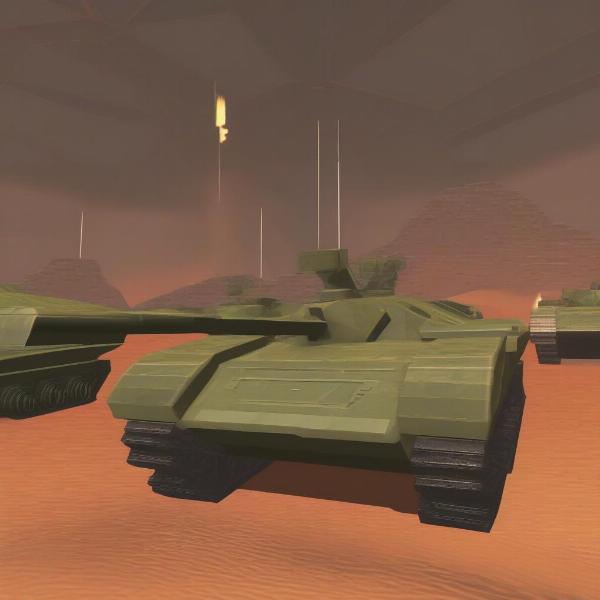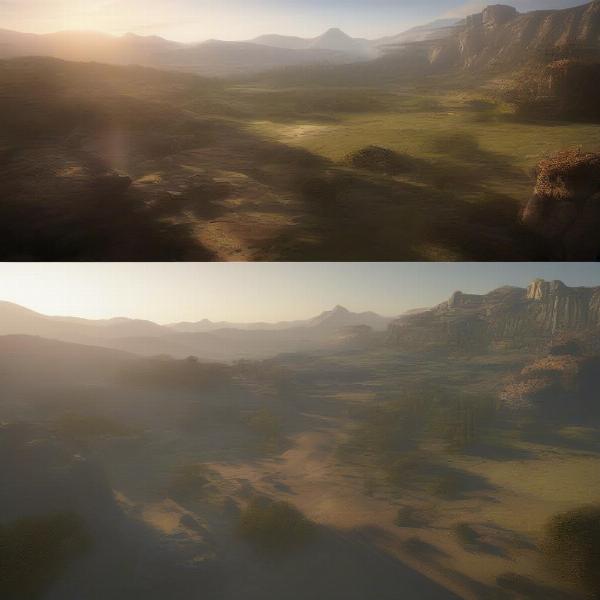The quest to answer “What Is The First 3d Game?” isn’t as straightforward as it seems. Defining “3D” in the context of early gaming involves considering various technological advancements and interpretations. While pinpointing a single definitive title is difficult, exploring the evolution of 3D graphics in video games unveils a fascinating journey of innovation. This article dives into the historical context, technical challenges, and key milestones that paved the way for the immersive 3D gaming experiences we enjoy today. Understanding the journey helps us appreciate the complexity and ingenuity behind the development of these early 3D games.
The Dawn of 3D: Early Attempts and Limitations
The earliest attempts at 3D graphics in video games were rudimentary by today’s standards. Limited processing power and memory meant developers had to employ creative techniques to simulate three-dimensional space. Many early games used clever tricks like “pseudo-3D” to create the illusion of depth. This involved utilizing sprites and carefully designed perspectives to create the perception of a 3D environment.
For instance, consider games like Maze War (1973). While not strictly a “3D” game in the way we understand it now, it’s considered a significant precursor. Players navigated a maze-like environment, with a limited form of perspective that hints at the three-dimensional concept. This game, however, lacked true 3D rendering capabilities.
Another important step was the creation of wireframe 3D graphics. These games, like Battlezone (1980), used vector graphics to represent objects, giving a sense of depth and perspective. However, the lack of textures and shading meant the visuals remained fairly simple.
 Early 3D Game Graphics: Battlezone's Wireframe Technology
Early 3D Game Graphics: Battlezone's Wireframe Technology
The limitations of early 3D games stemmed primarily from technological constraints. Early computers lacked the processing power needed for complex polygon rendering and texture mapping. The memory available was severely limited, preventing the creation of large and detailed 3D environments.
The Rise of Polygon-Based 3D: A New Era
The true turning point in 3D gaming arrived with the development of polygon-based rendering. Instead of relying on simple vectors, games started using polygons to represent objects. This approach allowed for more complex shapes and the ability to introduce shading and texture mapping.
One of the earliest examples of a game employing this technology is Space Wars (1975). Though still a relatively simple game by today’s standards, its use of polygons represented a key advancement that distinguished itself from previous methods of creating a three-dimensional environment, paving the way for subsequent generations of true 3D games.
The arcade game Star Wars (1983) further pushed the boundaries of polygon-based 3D graphics, albeit in a limited capacity. The game’s visuals, while rudimentary by today’s standards, showcased a significant leap in representing complex shapes and movements in a 3D environment that was a direct improvement upon earlier attempts to portray three-dimensional space.
The First “True” 3D Game? A Matter of Perspective
Defining the “first” 3D game remains subjective, as different criteria can be used. Some might argue that the title should belong to a game with fully textured and shaded polygon models in a vast, explorable 3D world. Others might consider the earliest game to use any form of 3D rendering, regardless of its limitations.
Looking back, the transition to full 3D was a gradual process, with many titles contributing to the evolution of this technology. It wasn’t a single breakthrough but a series of refinements and innovations from many developers. The “first” truly depends on your interpretation of the definition of 3D gaming.
It’s important to recognize the substantial technological leap involved in creating even simple 3D games. Understanding these obstacles allows us to appreciate the creative problem-solving and innovative techniques employed by early game developers. Their work laid the foundation for the visually stunning and immersive worlds we encounter in contemporary gaming.
The Impact of Technological Advancements
The development of faster processors, more memory, and advanced graphics cards significantly influenced the evolution of 3D gaming. As technology improved, game developers could create increasingly complex and realistic 3D worlds.
The release of the PlayStation and Nintendo 64 consoles marked a significant turning point. These consoles brought 3D gaming into the mainstream, showcasing higher polygon counts, improved textures, and more sophisticated rendering techniques. Suddenly, complex 3D worlds were achievable, a direct outcome of the progress in technology.
For example, games like Super Mario 64 (1996) and Crash Bandicoot (1996) greatly increased the standards for 3D platforming. These games utilized 3D polygonal models and textures in ways not before imagined and helped push the boundaries of 3D rendering in the late 1990s. The gameplay innovation also went hand-in-hand with the graphic advancements, creating the basis for many popular 3D video games that followed in their footsteps.
 Super Mario 64: A Milestone in 3D Gaming
Super Mario 64: A Milestone in 3D Gaming
The introduction of more sophisticated lighting and shadowing techniques further enhanced the realism of 3D games. Real-time lighting calculations, once deemed impossible, became commonplace, leading to more immersive and believable gaming experiences. This advancement allowed developers to create much more believable and realistic visual representations of virtual worlds.
Similar to progress made with 3D rendering, this advancement in lighting and shadowing technology improved the overall gameplay experience because of the enhanced visual immersion of the three-dimensional environments.
Modern 3D Gaming: A Continuous Evolution
Today, 3D gaming has reached new heights. Advanced rendering techniques, such as ray tracing and global illumination, create incredibly realistic visuals. High polygon counts allow for intricate character models and detailed environments. The improvements are nothing short of remarkable when compared to the early attempts at 3D gaming.
Modern game engines, like Unreal Engine and Unity, provide developers with powerful tools to create visually stunning and immersive 3D worlds. These engines not only ease the development process but also unlock new possibilities and creative innovation in 3D gaming.
Beyond the Graphics: The Essence of 3D Gaming
While the visual aspects are crucial, it’s important to remember that 3D gaming is about more than just graphics. The sense of immersion, the ability to explore and interact with a three-dimensional environment, and the freedom of movement are defining elements of the 3D gaming experience. This is something that is often overlooked in discussions regarding the history of 3D gaming. It is important to note that this concept was not lost on the early creators of 3D games. They understood this fact and utilized the technological advancements available to them to enhance the gameplay experience that is created with three-dimensional gaming.
“The true magic of 3D gaming isn’t just about the visuals,” says renowned game designer, Dr. Anya Sharma. “It’s about creating a world the player can truly inhabit and interact with on a deeper level.”
This quote helps emphasize the importance of game design and how it ties into the overall experience of 3D gaming. It should be noted that this is not solely related to the visuals of the game, but also the manner in which game mechanics are tied into the experience.
 Modern 3D Game Graphics: A Testament to Technological Advancement
Modern 3D Game Graphics: A Testament to Technological Advancement
Frequently Asked Questions
What was the first game to use 3D polygons?
Pinpointing the absolute first is difficult due to varying definitions of “3D,” but early contenders include Space Wars and various arcade games that experimented with polygon-based rendering in the mid-to-late 1970s.
How did early 3D games overcome technological limitations?
Early developers used techniques like pseudo-3D and wireframe rendering to simulate 3D spaces despite limitations in processing power and memory. Creative level design and clever visual tricks also played a significant role.
What role did consoles play in popularizing 3D gaming?
The PlayStation and Nintendo 64 were pivotal in bringing 3D gaming to a wider audience, offering improved graphics capabilities and more accessible platforms. The leap in technology made complex 3D experiences achievable for a mass audience.
What are some key innovations that have driven the evolution of 3D gaming?
Key innovations include the shift from wireframe to polygon-based rendering, the introduction of texture mapping and shading, advancements in real-time lighting and shadowing, and the development of powerful game engines.
What’s next for 3D gaming?
The future likely involves continued advancements in realism, driven by technologies like ray tracing and virtual reality (VR). We can anticipate more immersive and interactive experiences, pushing the boundaries of what’s possible. Developing higher quality games with increasingly realistic features.
“The journey of 3D gaming is far from over,” adds Dr. Sharma. “We’re constantly pushing the boundaries of what’s possible, and the future holds incredible potential.”
Dr. Sharma’s insight underscores the ongoing evolution of this technological and creative space, reiterating the continuing development of both the software and hardware involved in the process.
Conclusion
The question of “what is the first 3D game?” remains a topic of debate. The evolution of 3D gaming wasn’t a single event but a gradual process of technological advancement and creative problem-solving. From early experiments with pseudo-3D to the incredibly realistic visuals of modern games, the journey reflects the ingenuity and relentless pursuit of innovation within the gaming industry. Understanding this history allows us to better appreciate the sophisticated 3D gaming experiences we enjoy today. To learn more about game development, consider reading how much does making a video game cost. For more information on classic game systems, you might be interested in where to play second gen pokemon game. Understanding game saving mechanics can be helpful, so check out how to save game animal crossing for further insights. If you’re curious about starting new games, articles like how do you start a new game in pokemon x and how to start new game on pokemon omega ruby offer step-by-step guidance.

